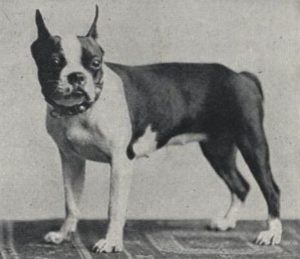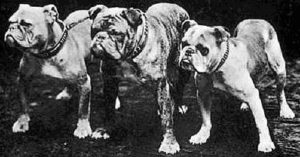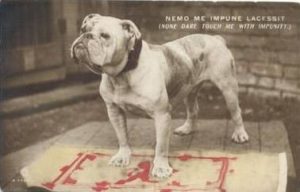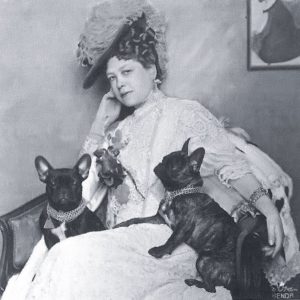Boston Terrier, English and French Bulldog.
Varieties that look similar to each other are not always closely related, according to DNA
research. However, the Boston Terrier and the English and French Bulldog are (Parker
2012). Even though in the FCI a French origin is claimed chauvinistically, the
French Bulldog is originally an Englishman. That also applies to the American Boston
Terrier, who seen superficially apart from his longer legs and less compact construction
a brother of the French Bulldog.
Bull baiting
Bulldogs derive their name from an English sport that is particularly popular in the past, bull
baiting (bull biting). Already in the Middle Ages people were allowed to play with wild or for entertainment
dangerous animals, such as bears and bulls, fight. Among the English monarchs Henry VIII
(1509-1547) and Elizabeth I (1558-1603) this was initially a pleasure for the
elite. Originally large dogs were used that their opponents bite true
they could.
Gradually the bull baiting developed into a real one in the following centuries
popular sport, in which people could bet heavily. As a result, more and more rules came about
to which baiting had to comply.
Nose
When bull baiting a bull – on market places or in specially built theaters – with
a rope of about five meters around his neck tied to a pole or a ring in the ground,
so that he had just enough room to turn around. The highest rating received
dogs who were able to bite stuck in the bull’s nose and did not let go until the bull
gave up. The madman of the bull first tried the dog with a lot of violence
to shake off. Dogs that thereby let go, sometimes flew up to ten meters high
through the air and fell to pieces. This resulted in people trying the dogs
to catch their break.
Bloody spectacle
Bulls that were used more often for baiting soon learned to keep their heads very low
to protect their nose and to be able to take dogs on the horns. That is why they started
train dogs to approach the bull crawling. Then there were sometimes, to the bull
to offer more opportunities, special dimples in the ground where he could get his nose
stop. This increased the chance that the dog would end up in the horns
being torn open or thrown into the air. So bull baiting could be a hugely exciting and
bloody spectacle. In view of the success of this ‘blood sport’, this fell to many in the
taste.
Centenbakkie
In the beginning, all kinds of dogs were used for bull baiting. Main requirement
was that they were not too scared to attack the bull. Because, however, gradually
the emphasis was placed on getting stuck in the bull’s nose, people started to become dogs
select those who also had the right papers physically: dogs that were not too large
with strong jaws and a hefty underbite. By the ‘centenbakkie’, where the teeth of the
protruding lower jaw not as normally connected to the teeth of the upper jaw,
the nose came to lie behind the lower teeth. This made it easier for
a dog to breathe while he had been bitten into something.
Law
Not everyone was charmed by the bloody spectacle in which bulls were molested
and many dogs succumbed to horrendous injuries. Touched the nobility and elite
the bull baiting at the end of 17th
century out of fashion after King James II had his disapproval
show. With the common people, however, the sport remained incredibly popular. It lasted till
1835 before a law – the Cruelty to Animals Act – was adopted by the British
parliament with which ill-treatment or cruel treatment of domesticated animals
punishable. That meant the end of the eye-catching bull baiting and one
shift to the easier to keep dog fights.
National symbol
With that, the bulldog was doomed to extinction. However, he was revived when
around 1860 beauty contests for dogs began to be held and one for that
bulldogs started to breed again. Bulldogs were also loved for a different reason
in England: they were due to their stable character, reliability, courage and tenacity
a national symbol alongside John Bull, who – like Uncle Sam for America – since the end of the 18th
century in political cartoons was the personification of the British Empire.
Transformation
The bulldogs that were once used for bull baiting were not usually sweeties. In
In 1845 they were still described as barely trainable and only suitable for fighting.
They were strong, well-proportioned, athletic, medium-sized dogs.
Because after 1860, however, was bred for dog shows, the bulldog already underwent
quickly a huge transformation in appearance and behavior. After all, there was now only
selected on bulldogs that were suitable for a new career as show and
family dog. It has been suggested that for this purpose the elite as a lap and family dog
hugely popular and extremely friendly pug is crossed out, but from global DNA
research does not show this. Perhaps more research will be done about this in the future
to give a definitive answer. Since there was no breed standard, all shows were on one at the shows
Bulldog-like dogs with an underbite and a broad head as a bulldog. Thereby
were dogs of all sizes and weights, which could vary from large dogs
35 kilos to small ones of 7 kilos. Between 1860 and 1870 such bulldogs were in two
classes, with a weight of 10 kilos forming the dividing line.
Club
As early as 1875 the Bulldog Club was established. Reason was to prevent the English bulldog
with the very large Spanish Bulldog was crossed. A standard was drawn up, where
they concentrated on not too big, but certainly not too small dogs. On English
shows disappeared the class for bulldogs under 10 kilos.
However, the handy little bulldogs were hugely popular in the meantime
in France after being noticed by the French in England or in Normandy
where they had come with English emigrants. Many dogs were sent to France
exported, including especially bulls with the ugly ears found in England.
A breeder, James Hinks, is told that he received an order from France
every Bulldog under the 10 kilo he could find in England to send to France.
Colette.
The small bulldogs that were recognized as French Bulldogs in 1885 were extremely popular
by their exuberant, clownish and amiable character. The famous French writer
Colette (1873-1954) gave birth to the bulldog in the house of my mother
her childhood, Toutouque. She was so gentle that she allowed herself to be pecked by chicks.
Little pussies were entrusted to her to lick clean. Colette’s brother mentioned
the dog affectionately a “sympathetic cylinder”. She was “broad and low like one
piglet of four months … .One couple of unstumbling had her stubborn ears in a pointed
shape cut and her tail cut all the way to her buttocks. “When one
fellow countryman complaining that Toutouque has bitten his Setter, the family bursts
also in “shameless laughter, and we pointed to Toutouque who lazy and blissfully on the
ground while she was being scratched by a small domineering kitten “. Great is then the
dismay of Colette when she sees how Toutouque “like a kind of yellow monster with
upright hair … a good set of teeth, bulging eyes and a purplish tongue with
foaming saliva “the Setter the whole village” with an unimaginable speed
and to graze.
Expensive
It was especially the big, soft eyes that looked straight at you, round, flat, at a human being
looking face and the round body shape of the bulldog, where people fell for and fall.
According to scientists and enthusiasts, the resemblance with a chubby baby (unconsciously)
an irresistible attraction to many people.
Between 1890 and 1909 the bulldog was extremely popular. In 1909 there were in
England registered as many as 1700 bulldogs in the studbook and still he stands
England in the top ten of the most popular varieties. Around 1890 the bulldog was not alone
one of the most popular, but also one of the most expensive varieties. Prices were between £ 300
and £ 600; unprecedented high prices at a time that the annual income of a carpenter about
£ 100 and that of a doctor £ 300. More was paid for champions. In front of
some bulldogs sold to America between 1901 and 1904 even became £ 1000
paid per dog.
Bulldogly
It is probably chauvinism and perhaps the high prices that went for it
ensured that the Americans also wanted to create their own bulldog-like breed. The race –
after mature consideration, called Boston Terrier – would be called an American Bull and Terrier
Judge, to have ancestor. Judge was a cross between an English Bulldog and a white one
Terrier. Solid crossings were at the end of 19th
century particularly popular in England and
America. They were often used for dog fights. However, the Boston Terrier was
from the beginning bred as a show and family dog and after recognition as a breed in 1893 as well
together with the bulldogs by American Kennel Club (AKC) classified under the ‘nonsporting’
breeds and not among the terriers. In the years 1880 -1890 in which the breed became
created, French Bulldogs were frequently intruded, which is clearly visible in the
ears of the Boston Terrier. It is also charming, exuberant, amiable, but steadfast
character shares the Boston Terrier with the French Bulldog.
Ears
That the Boston Terrier and the French Bulldog are all standing ‘tulip-ears’ nowadays
may also have to do with chauvinism and rivalry in the French and
Americans existed with respect to the English, who frequent their political opponents
(had) been. All Bulldogs and also the Boston Terriers came in the beginning period with
both standing and to a greater or lesser extent hanging ears. The English found one
standing ear ugly and considered it a mistake. Their ideal for the
The English Bulldog was the back-folded ear, called rose ear.
Caesarean
Breeding on a certain appearance also had fewer innocent consequences. Already in the
early breed standards of the French and English Bulldogs were emphasized on it
have a powerful, compact construction, a round wide skull and a short muzzle with
many folds, in which the nose was almost between the eyes. The English bulldog was respected
of the skull even remarked: the bigger, the better.
By breeding selectively on ever larger and wider heads is the head of the English
Bulldog in relative meanwhile also become so big and wide that 80% of the
puppies can only be born with the caesarean section. Also with the French Bulldog and the
Boston Terriers are relatively often the case.
Babyface
Probably because of the attraction that the ‘babyface’ of the bulldogs unconsciously
exercised, the ideal of the breed standard was also followed so exaggeratedly and so
honored by judges with placements that the snouts became extremely short.
Now a broad skull with a short snout and also dwarfism with
comparatively shorter legs or strangely curled tails do not normally occur in dogs
unusual or very wrong. Such deviating forms are already early
in the process of domestication caused by gene mutations and are relatively common. The
This is, in fact, about growth abnormalities – brachycephaly and chondrodysplasia
a serious form can seriously affect the well-being of the dogs.
Breathing difficulty
By breeding on extremely short snouts with the French and English Bulldog and Boston Terrier
arose, due to a lack of space, all kinds of anatomical deviations and
malformations, such as narrowed nostrils and a too narrow windpipe, which is normal
hamper functioning. A bulldog breathes through a straw, as it were. He must be huge
do its best to get enough air. Because the soft palate
proportionally further to the rear, it becomes a piece of inspiration when inhaled
sucked in the throat, blocking the inhalation even further.
The so charmingly found snoring and gritting of bulldogs is in fact the result
of a difficult breathing, as a result of which the dog continuously has a little oxygen deprivation.
In case of exertion and in hot weather when the dogs have to be able to pant, bulldogs can then
also get pretty breathless. In addition, they can become dangerously overheated
because they can not adequately dissipate their heat.
BBC documentary
With an unimaginable speed running through a whole village behind another dog like
Toutouque in 1883 with ease, there is not for most current bulldogs
more. Only recently thanks to the critical BBC documentary Pedigree Dogs exposed
2009 attempts made in Europe to turn the tide. For example, the FCI breed standard is numerous
of points adapted to the respiratory problem, the size of the head and the length of
to deal with the muzzle. Unfortunately, the American Kennel Club did not follow this example
and not insisted with the American Bulldog Club to adjust the breed standard. The
Bulldog is in sixth place in America of most popular breeds, just behind the Golden
Retriever. Breeders are worried that changes in muzzle length will cause “the
Bulldog the Bulldog is no longer “.
The Netherlands first
The Netherlands, on the other hand, is leading the way in improving the welfare of the English Bulldog. If
First, the Board of Directors, together with the English Bulldogs clubs, decided that the
dogs for a fitness test have to succeed to be allowed to breed: no successful
fitness test, no pedigree.
The test painfully shows how sad it is with the health of the
current bull-hunter. To succeed, the dog on the line within a distance of twelve minutes
of 1000 meters and his heart rate and temperature after fifteen minutes
the same level as the quarter before this walk. It is apparently already one
whole performance if a bulldog can keep a smooth walking man (5 km per hour)!
Scientific literature:
Parker, Heidi G. (2012). Analyzes or modern dog breeds. Mammalian Genome 23, 19-27.

Boston Terrier around 1910.

Boston Terrier around 1900
Text: Elian Hattinga van ‘t Sant
© Elian Hattinga van ’t Sant / Hondenmanieren 2014





